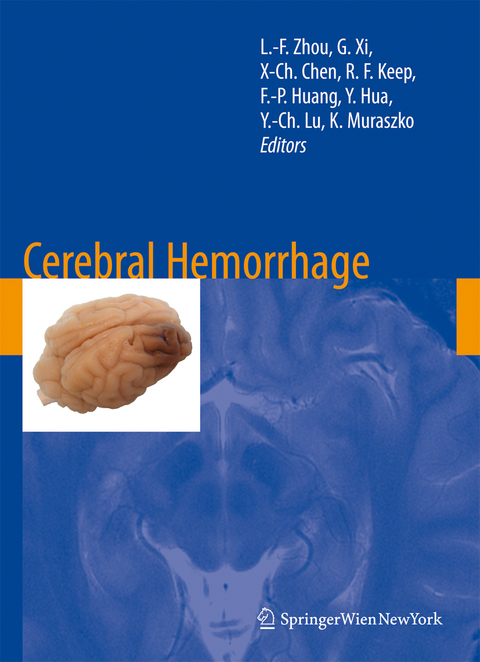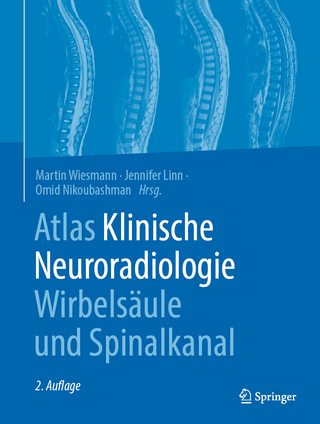
Cerebral Hemorrhage
Springer Wien (Verlag)
978-3-211-99870-0 (ISBN)
Experimental intracerebral hemorrhage - iron, hemoglobin and free radicals.- Deferoxamine therapy for intracerebral hemorrhage.- Bilirubin oxidation products, oxidative stress, and intracerebral hemorrhage.- Deferoxamine reduces brain swelling in a rat model of hippocampal intracerebral hemorrhage.- The antioxidant effects of melatonin after intracerebral hemorrhage in rats.- Poly(ADP-ribose) polymerase activation and brain edema formation by hemoglobin after intracerebral hemorrhage in rats.- Induction of autophagy in rat hippocampus and cultured neurons by iron.- Effects of superoxide dismutase and catalase derivates on intracerebral hemorrhage-induced brain injury in rats.- Metallothionein and brain injury after intracerebral hemorrhage.- Experimental intracerebral hemorrhage - inflammation and thrombin.- Intracerebral hemorrhage injury mechanisms: glutamate neurotoxicity, thrombin, and Src.- Increase in brain thrombin activity after experimental intracerebral hemorrhage.- Microglial activation and intracerebral hemorrhage.- Concomitant intracerebral infusion of tissue plasminogen activator and thrombin leads to brain injury.- Microglial activation and brain injury after intracerebral hemorrhage.- Effects of aging on complement activation and neutrophil infiltration after intracerebral hemorrhage.- Experimental intracerebral hemorrhage - other mechanisms.- Blood-brain barrier function in intracerebral hemorrhage.- Treatment of stroke and intracerebral hemorrhage with cellular and pharmacological restorative therapies.- Deficiency of CD18 gene reduces brain edema in experimental intracerebral hemorrhage in mice.- Tissue inhibitor of matrix metalloproteinases-3 (TIMP-3) lacks involvement in bacterial collagenase-induced intracerebral hemorrhage in mouse.- Radialglia marker expression following experimental intracerebral hemorrhage.- Long-term effects of melatonin after intracerebral hemorrhage in rats.- Management of delayed edema formation after fibrinolytic therapy for intracerebral hematomas: preliminary experimental data.- Erythropoietin attenuates intracerebral hemorrhage by diminishing matrix metalloproteinases and maintaining blood-brain barrier integrity in mice.- Hyperbaric oxygen for experimental intracerebral hemorrhage.- Effect of amantadine sulphate on intracerebral hemorrhage-induced brain injury in rats.- Experimental intracerebral hemorrhage - model development and characterization.- Long-term behavioral characterization of a rat model of intracerebral hemorrhage.- Neurological deficits and brain edema after intracerebral hemorrhage in Mongolian gerbils.- Rat model of intracerebellar hemorrhage.- A rat model of pontine hemorrhage.- Human intracerebral hemorrhage.- The optimal time-window for surgical treatment of spontaneous intracerebral hemorrhage: result of prospective randomized controlled trial of 500 cases.- Preliminary findings of the minimally-invasive surgery plus rtPA for intracerebral hemorrhage evacuation (MISTIE) clinical trial.- Pediatric cerebrovascular diseases: report of 204 cases.- Xenon-CT study of regional cerebral blood flow around hematoma in patients with basal ganglia hemorrhage.- Preliminary application of pyramidal tractography in evaluating prognosis of patients with hypertensive intracerebral hemorrhage.- Experimental intracranial hemorrhage (non-intracerebral hemorrhage).- Mechanisms and markers for hemorrhagic transformation after stroke.- The clinical significance of acute brain injury in subarachnoid hemorrhage and opportunity for intervention.- Development of a cerebralmicrovascular dysplasia model in rodents.- Hyperbaric oxygen preconditioning protects against traumatic brain injury at high altitude.- Human intracranial hemorrhage (non-intracerebral hemorrhage).- Genetic considerations relevant to intracranial hemorrhage and brain arteriovenous malformations.- Vasospasm after aneurysmal subarachnoid hemorrhage: need for further study.- Regional cerebral blood flow and oxygen metabolism in aneurysmal subarachnoid hemorrhage: positron emission tomography evaluation of clipping versus coiling.- Preliminary report of the clot lysis evaluating accelerated resolution of intraventricular hemorrhage (CLEAR-IVH) clinical trial.- Leptin plays a role in ruptured human brain arteriovenous malformations.- Novel treatments for cerebral vasospasm following aneurysmal subarachnoid hemorrhage.- Relationship between serum sodium level and brain ventricle size after aneurysmal subarachnoid hemorrhage.- Lack of association between apolipoprotein E promoters in 4? carriers and worsening on computed tomography in early stage of traumatic brain injury.
| Erscheint lt. Verlag | 19.10.2010 |
|---|---|
| Reihe/Serie | Acta Neurochirurgica Supplement |
| Zusatzinfo | XIII, 239 p. 200 illus. |
| Verlagsort | Vienna |
| Sprache | englisch |
| Maße | 210 x 277 mm |
| Gewicht | 613 g |
| Themenwelt | Medizinische Fachgebiete ► Chirurgie ► Neurochirurgie |
| Medizin / Pharmazie ► Medizinische Fachgebiete ► Neurologie | |
| Schlagworte | Aneurysm • brain • Brain Injury • Cerebral hemorrhage • neurons • Oxidative stress • positron emission tomography (PET) • stroke • Surgery • Tomography • Trauma • traumatic brain injury |
| ISBN-10 | 3-211-99870-5 / 3211998705 |
| ISBN-13 | 978-3-211-99870-0 / 9783211998700 |
| Zustand | Neuware |
| Informationen gemäß Produktsicherheitsverordnung (GPSR) | |
| Haben Sie eine Frage zum Produkt? |
aus dem Bereich


